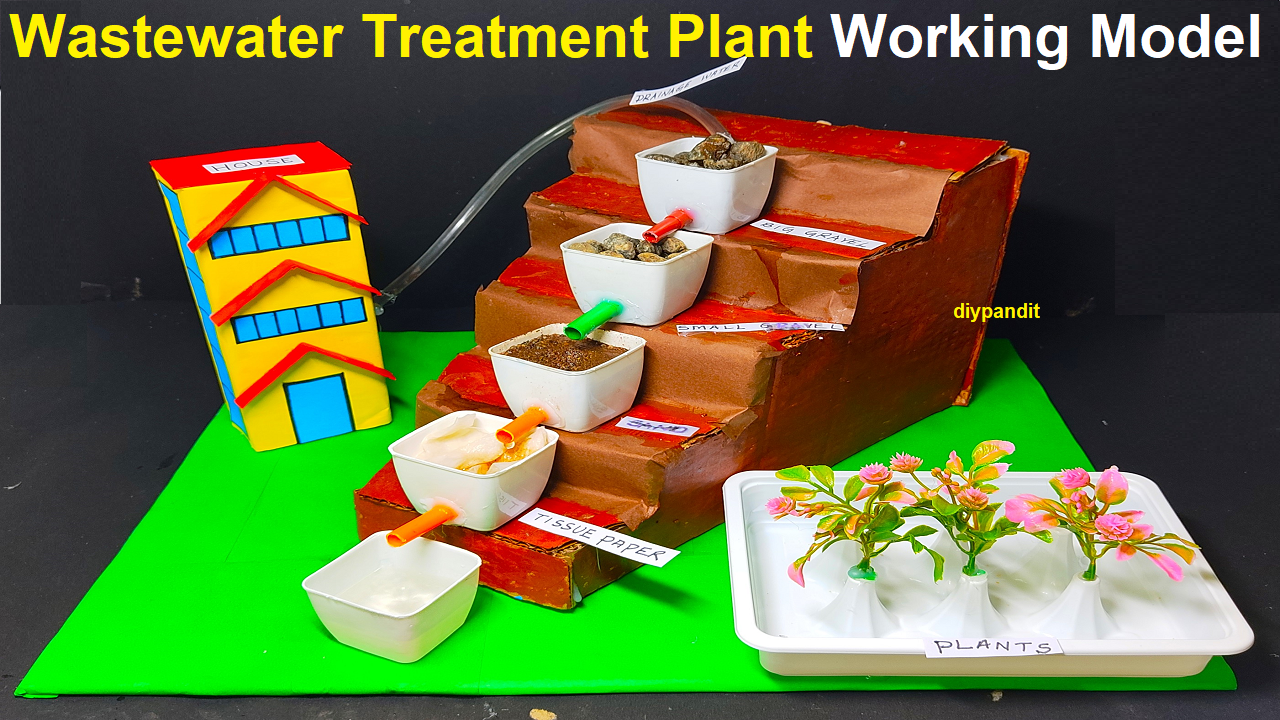Creating a wastewater treatment plant working model with stepwise stages of water purification using sand, gravel, and cotton can be an educational and informative project.

Here’s a guide to help you build a simple yet effective model:
Materials Needed:
- Large plastic container or tray (base for the model)
- Small plastic containers or cups
- Sand
- Gravel or small pebbles
- Cotton or filter fabric
- Activated charcoal (optional)
- Small pump (optional)
- Plastic tubing
- Small plastic figurines or toy animals (to represent pollutants)
- Water
- Labels and markers for labeling parts
- Decorative materials (optional)
Step by Step Video Instructions wastewater treatment plant working model :
1. Prepare the Base:
- Use a large plastic container or tray as the base for your model.
2. Label Different Stages:
- Label different sections of the container to represent each stage of water purification: Screening, Filtration, and Polishing.
3. Screening Stage:
- Place small plastic containers or cups at the beginning of the model to represent the screening stage. These containers act as the entry point for wastewater.
4. Filtration Stage:
- Fill the first container with gravel to simulate the initial filtration stage. The gravel will help trap larger particles.
- In the next container, add a layer of sand. This represents the finer filtration stage, where smaller particles are captured.
- Optionally, you can add a layer of activated charcoal to simulate an additional purification step. This helps remove impurities and odors.
- Cover each container with cotton or filter fabric to mimic the filtering process. Water should pass through these materials while retaining particles.
5. Polishing Stage:
- Set up a final container with clean sand or gravel to represent the polishing stage. This stage further refines the water quality.
- If you have a small pump, you can circulate water through the system to simulate the continuous flow in a real wastewater treatment plant.
6. Add Pollutants:
- Introduce small plastic figurines or toy animals into the water to represent pollutants. These will move through the stages of purification.
7. Decoration (Optional):
- Decorate the model with labels, markers, or decorative materials to make it visually appealing and educational.
8. Presentation:
- During your presentation, explain the purpose of each stage, how pollutants are removed, and the importance of water purification for environmental protection.
Presentation Ideas:
- Discuss Each Stage:
- Provide information on the screening, filtration, and polishing stages, and their significance in water treatment.
- Demonstrate Water Flow:
- Use the pump (if available) to circulate water through the model, demonstrating the flow of wastewater through each stage.
- Explain Filtration Materials:
- Discuss why sand, gravel, and cotton are used in each stage and how they contribute to removing impurities.
- Emphasize Environmental Impact:
- Explain how wastewater treatment is crucial for protecting the environment and ensuring the availability of clean water.
- Interactive Session:
- Encourage your audience to ask questions and interact with the model to enhance their understanding of wastewater treatment.
This wastewater treatment plant model provides a hands-on visual representation of the purification process and can effectively convey the importance of treating wastewater before it is released back into the environment. Adjust the complexity based on your audience and available resources.

